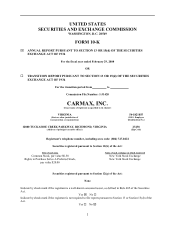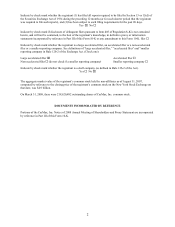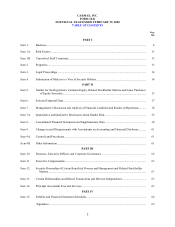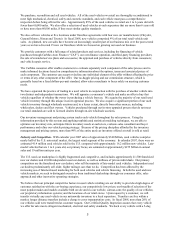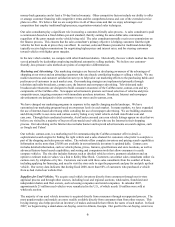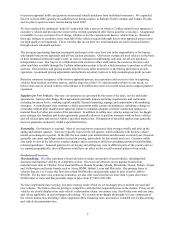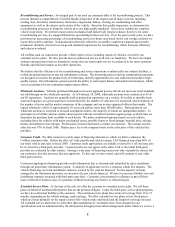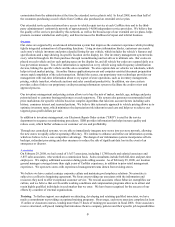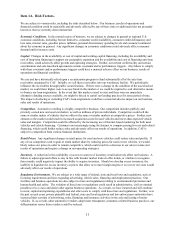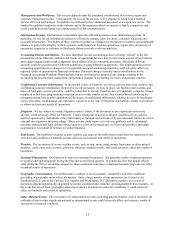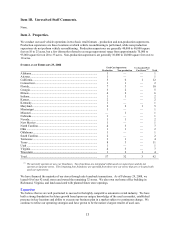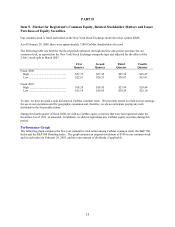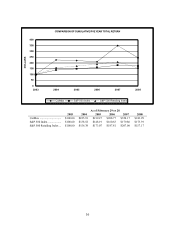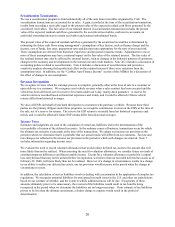CarMax 2008 Annual Report Download - page 23
Download and view the complete annual report
Please find page 23 of the 2008 CarMax annual report below. You can navigate through the pages in the report by either clicking on the pages listed below, or by using the keyword search tool below to find specific information within the annual report.11
Item 1A. Risk Factors.
We are subject to various risks, including the risks described below. Our business, results of operations and
financial condition could be materially and adversely affected by any of these risks or additional risks not presently
known or that we currently deem immaterial.
Economic Conditions. In the normal course of business, we are subject to changes in general or regional U.S.
economic conditions, including, but not limited to, consumer credit availability, consumer credit delinquency and
loss rates, interest rates, gasoline prices, inflation, personal discretionary spending levels and consumer sentiment
about the economy in general. Any significant changes in economic conditions could adversely affect consumer
demand and/or increase costs.
Capital. Changes in the availability or cost of capital and working capital financing, including the availability and
cost of long-term financing to support our geographic expansion and the availability and cost of financing auto loan
receivables, could adversely affect growth and operating strategies. Further, our current credit facility and certain
securitization and sale-leaseback agreements contain covenants and/or performance triggers. Any failure to comply
with these covenants and/or performance triggers could have a material adverse effect on our business, results of
operations and financial condition.
We use and have historically relied upon a securitization program to fund substantially all of the auto loan
receivables originated by CAF. Initially, we sell these receivables into our warehouse facility. We periodically
refinance the receivables through public securitizations. If there were a change in the condition of the asset-backed
market, we could incur higher costs to access funds in this market or we could be required to seek alternative means
to finance our loan originations. In the event that this market ceased to exist and there were no immediate
alternative funding sources available, we might be forced to curtail our lending practices for some period of time.
The impact of reducing or curtailing CAF’ s loan originations could have a material adverse impact on our business,
sales and results of operations.
Competition. Automotive retailing is a highly competitive business. Our competition includes publicly and
privately owned new and used car dealers, as well as millions of private individuals. Competitors could sell the
same or similar makes of vehicles that we offer in the same or similar markets at competitive prices. Further, new
entrants to the market could result in increased acquisition costs for used vehicles and lower-than-expected vehicle
sales and margins. Competition could be affected by the increasing use of Internet-based marketing for both used
vehicles and vehicle financing. Customers are increasingly using the Internet to compare pricing for cars and related
financing, which could further reduce sales and adversely affect our results of operations. In addition, CAF is
subject to competition from various financial institutions.
Retail Prices. Any significant changes in retail prices for used and new vehicles could reduce sales and profits. If
any of our competitors seek to gain or retain market share by reducing prices for used or new vehicles, we would
likely reduce our prices in order to remain competitive, which could result in a decrease in our sales revenue and
results of operations and require a change in our operating strategies.
Inventory. A reduction in the availability or access to sources of inventory would adversely affect our business. A
failure to adjust appraisal offers to stay in line with broader market trade-in offer trends, or a failure to recognize
those trends, could negatively impact the ability to acquire inventory. Should we develop excess inventory, the
inability to liquidate the excess inventory at prices that allow us to meet margin targets or to recover our costs would
adversely affect our results of operations.
Regulatory Environment. We are subject to a wide range of federal, state and local laws and regulations, such as
licensing requirements and laws regarding advertising, vehicle sales, financing and employment practices. Our
facilities and business operations are also subject to laws and regulations relating to environmental protection and
human health and safety. The violation of these laws or regulations could result in administrative, civil or criminal
penalties or in a cease and desist order against business operations. As a result, we have incurred and will continue
to incur, capital and operating expenditures and other costs to comply with these laws and regulations. Further, over
the past several years, private plaintiffs and federal, state and local regulatory and law enforcement authorities have
increased their scrutiny of advertising, sales, financing and insurance activities in the sale and leasing of motor
vehicles. If, as a result, other automotive retailers adopt more transparent, consumer-oriented business practices, our
differentiation versus those retailers could be reduced.


